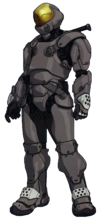Semi-Powered Infiltration armor: Difference between revisions
From Halopedia, the Halo wiki
| Line 53: | Line 53: | ||
*''[[Halo: Evolutions - Essential Tales of the Halo Universe]]'' | *''[[Halo: Evolutions - Essential Tales of the Halo Universe]]'' | ||
**''[[Headhunters (short story)|Headhunters]]'' | **''[[Headhunters (short story)|Headhunters]]'' | ||
*''[[Halo: Glasslands]]'' | |||
==Sources== | ==Sources== | ||
Revision as of 13:55, October 2, 2012
| This article does not have enough inline citations and/or does not adhere to the proper citation format. You can help Halopedia by adding citations. |

The Semi-Powered Infiltration armor (SPI armor) is an experimental armor system developed for use by the SPARTAN-IIIs.
Overview
Though more advanced than the Orbital Drop Shock Troopers' body armor, the SPI armor is far less advanced and powerful than the MJOLNIR Powered Assault Armor used by the SPARTAN-IIs. Its main benefit is that it is drastically cheaper to produce than the MJOLNIR armor; the SPI armor was designed with an emphasis on stealth rather than on raw power.
The armor features special photo-reactive panels that mimic the surrounding textures, effectively being the UNSC equivalent to the Covenant's active camouflage systems. It has been described as part "legionnaire mail, part tactical body armor, and part chameleon" by both Tom-B292 and Dr. Catherine Halsey.[1]
Versions
Mark I
The Mark I was used by the SPARTAN-IIIs of Alpha Company. It featured hardened plates and photo-reactive panels. Though advanced compared to standard UNSC infantry armor, it could only take a few glancing blows before failing.[2] It featured full body armor with an enclosed helmet and heads-up display. It was also equipped with a cushioning layer of liquid nanocrystals that provided more ballistic protection than three centimeters of Kevlar diamond weave, without the bulk. The featured photo-reactive panels gave the SPARTANs of Alpha Company a rough equivalent to active camouflage. The camouflage patterns, however, shifted irregularly and imperfectly, which made the photo-reactive panels inferior compared to the Covenant's active camouflage technologies.
Mark II
The Mark II was an improvement version of the SPI Mark I, first used by the drill instructors of Beta Company, and then by the SPARTANs of Beta Company. The armor sports new photo-reactive coating to boost their camouflaging properties. There were also numerous experimental refits to the ballistic gel layers, upgraded software suites, and other functions. Although the new photo-reactive coating could mimic a wide range of electromagnetic radiation, it was still sensitive to overload, so the wearer would still be vulnerable for several seconds after a flashbang or plasma hit while the panels reset.[3] One minor improvement is that the armor is now hermetically sealed.
The armor was proposed in 2537 for Alpha Company, but the request was denied because the armor was over budget. After Alpha Company's pyrrhic victory in Operation: PROMETHEUS, the Mark II was approved for mass production. After the augmentation of Gamma Company, small adjustments were installed into the SPI Armor Mark II.
Comparison to MJOLNIR
Advantages
- The armor is significantly cheaper and easier to mass produce than MJOLNIR armor.
- The system includes photo-reactive panels that act as an active camouflage for the wearer.
- The armor is easier to transport, because it is not as bulky or as heavy as the MJOLNIR armor.
- The armor has an efficient cooling system and is significantly difficult to detect even with thermal scanners.
- The faceplate has an automatic 5x zoom ability.[4]
Disadvantages
- It had no energy shielding system, unlike the SPARTAN-IIs' MJOLNIR Mark V and Mark VI models, making the user far more vulnerable to enemy fire and a major contributor to the high fatality rate of the SPARTAN-III's. The exception to this limitation could be found in the SPARTAN-III Headhunters: their experimental armor was known to be equipped with energy shields, due to their elite nature and value. However, power must be drawn from the energy shields to recharge the suit's active camouflage module.
- It does not grant the SPARTAN-IIIs enhanced strength, speed or agility, unlike MJOLNIR.
- Since the photo-reactive plates take time to recover after explosions such as a flashbang grenade and plasma hits, the SPARTAN-III is visible until the plates recover. With the exception of the Headhunters' suits, the SPI armor does not feature true active camouflage systems.
- It is made of a less durable, less dense alloy than MJOLNIR armor: Kelly-087 dented Holly-G003's chest plate with her fist when first encountering the SPARTAN-IIIs.
- The SPI armor cannot be used for long periods of time without the cooling system failing.
- It lacks the ability to support an onboard artificial intelligence construct, unlike the Mark V, Mark VI, and Black models of the MJOLNIR armor.
Trivia
- Some screenshots released by Bungie led to fans speculating that they would be able to use SPI armor in Halo 3. However, the armor was later revealed to be the MJOLNIR EVA variant.
- The UNSC Air Force Pilot helmet, the MJOLNIR EVA variant helmet, and the helmet worn by Marine Hellbringers all bear noticeable resemblance to the SPI helmet.
Gallery
- SpartanIII.jpg
Kurt-051 in Mark II SPI armor.
An energy shielded SPI suit's HUD. Note the HUD's resemblance to that of the MJOLNIR Mark V.
Jonah wearing his SPI armor.
List of appearances
- Halo: Reach (Mentioned only)
- Halo: Ghosts of Onyx (First appearance)
- Halo: Evolutions - Essential Tales of the Halo Universe
- Halo: Glasslands
Sources




